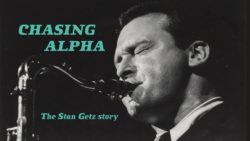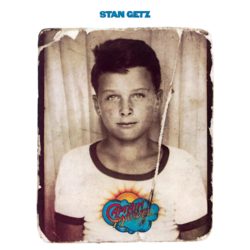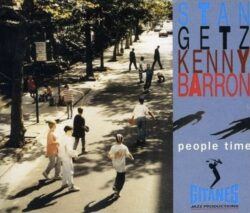Gratus Sumus Getz!

Norma Tanega sings Don’t sing if you want to live long, and I am fascinated by the final works of musical geniuses who sing and don’t live long. Especially if they know they are dying, and pen or perform what they surely know to be swan songs. My previous entry cast ears on Beethoven and his late quartets, and Bill Evan’s last stand at San Francisco’s jazz club, Keystone Corner. This post comments on Stan Getz’s coda.*
Among the jazz saxophonists who played between the 1950s and the eighties, Getz consistently ranked near the top, and was often the only white guy in the room. He was known for his fat, breathy tone, influenced by Lester Young, and a melodic inventiveness that distinguished his solos. Never upending, but always innovating, refining, and at his heights, defining jazz.

Stan Getz called on the extraordinary pianist Kenny Barron to accompany him on four dates in March of 1991, where they perspired just three months before Getz expired. He had produced a number of major works: The hallowed jazz albums Stan Getz Plays, Focus and Sweet Rain; Jazz Samba; Getz/Gilberto (which features the classic Girl from Ipanema); the bossa nova movement; the prog-jazz album Captain Marvel; and about another twenty highly rated albums. But for his final act Getz returned to the kind of gig you’d expect from a young and struggling musician just starting out.
Early in his career, 1955, his wife Monica Silfverskiöld arranged for him to play at the well-known Copenhagen café and club, Jasshus (Jazzhouse) Montmartre. Soon thereafter, his fee became more than the club could afford, but he returned for his final stand He played standards in the relaxed mode of piano accompaniment only.
 Released as the double CD People Time, his tone, distinctive and still very strong, sounds more like a man aching to live than one on the cusp of dying. But the liver cancer, of which he was well aware—you can hear some labored breathing on the recording—would end his life just three months later.
Released as the double CD People Time, his tone, distinctive and still very strong, sounds more like a man aching to live than one on the cusp of dying. But the liver cancer, of which he was well aware—you can hear some labored breathing on the recording—would end his life just three months later.
He played standards. Why? An act of humility from someone known for his dangerous addictions and difficult personality? Homage to the catalog that served as the vehicle that took him to the top? Or just because they’re such great tunes? Even more than “all of the above,” the return to standards completes the circle of a working musician’s life, riding the currents of melodies, rhythms and chords set down by the great songwriters of Tin Pan Alley, Broadway, film, radio, and records. Riding them back to their Source. He begins and ends his musical life playing crowd-pleasing standards that folks in the West hummed throughout the 20th century.
We don’t know much about what Getz felt or thought during his last days, except that he was in a lot of physical pain. Also, he may not have wanted us to know that much, for he was not always well-liked. Wikipedia goes so far as to reprint these two particular quips: “Zoot Sims, who had known Getz since their time with [Woody] Herman, once described him as ‘a nice bunch of guys’, an allusion to his unpredictable personality. Bob Brookmeyer, another performing colleague, responded to speculation Getz had a heart operation with a query: ‘Did they put one in?’”
Which is funny, and says a lot. Because Getz put his heart into every note. His thoughtful and complex jazz goes straight to your heart like a cannonball.

But in his final year of life, Getz finally achieved a lasting sobriety. After struggling with addictions for many years, this stand of duets in Copenhagen was paired with Getz making a series of amends with colleagues and friends the “nice bunch of guys” had wronged and offended in his past. The music of People Time doesn’t show a new Stan Getz, but instead that, without the aid of drugs, he is musically more than ever the very same Stan Getz.
At first, you may be fooled into thinking that this is laid-back cocktail hour music, you’re thinkin’ I got this. I know this kind of casual music, but give your heart to Stan and Kenny, and by each tune’s end, you’ll realize you’ve just heard something very special. Fluent, genius jazz improvisation is one way to describe it. Soulful feeling-pictures, jamming in death’s shadow would be another. You’ll find loving renditions of I Remember Clifford (Golson); Like Someone in Love(Van Heusen & Burke); The Surrey with the Fringe on Top (Rodgers & Hammerstein); People Time (Carter); Softly, As in a Morning Sunrise (Romberg & Hammerstein), Soul Eyes (Waldron), and more.
I especially recommend East of the Sun (and West of the Moon) (Bowman); Night and Day (Porter); and Gone with the Wind (Wrubel and Magidson). For a musical adventure that metamorphoses from Tin Pan Alley to stride to modernity, (There is) No Greater Love. For soft and romantic ballads, there’s First Song, written by Charlie Haden for his wife, Ruth, and People Time. Interest piqued? Read the biography Stan Getz: A Life in Jazz by Donald L. Maggin, where he assesses People Time and writes “Barron’s mind seems uncannily bonded to Stan’s as he creates with him, on every track, passages of daring and felicitous counterpoint.”
Stan Getz at the Copenhagen Airport (1958, SAS Airlines)
The selections are brilliantly curated from four nights of performances, not a clunker in the bunch—fourteen great performances of lush and feelingful interpretations. What a sweet farewell from a titan of jazz. Though it was his final performance, improbably or poetically, People Time is also an excellent introduction to Stan Getz. He was that consistent and professional, his standards (pun intended) were that high.


I mean, IF you find yourself in Sultan on May 18th . . . (at NOON) You just might find Your Trickster Self . . . Squeeeee!!!! I’ll be making a fun presentation at The Sultan Library 319 Main St Sultan, WA 98294 Saturday May 18th at Noon Tricking Power into Performing Acts of Love...
Haven’t seen the movie “Poor Things?” Want its surprises? Then GO SEE IT before you read this… and in the meantime, click the image below v v v A LITTLE PLUG FOR YOU BOOK CLUBBERS [CLICK!] In their 2018 period comedy The Favourite, Arizonan Emma Stone and Athenian Yorgos Lanthimos gave us clues of mischief...
HEY PLAYSTERS! Apropos of nothing, I want to share with you an excerpt from Disruptive Play: The Trickster in Politics and Culture. Well, not quite nothing. For the most direct route to Trickster essence is through its Great American Icon, Bugs Bunny. When I wrote Disruptive Play, not so long ago, I was certain that...